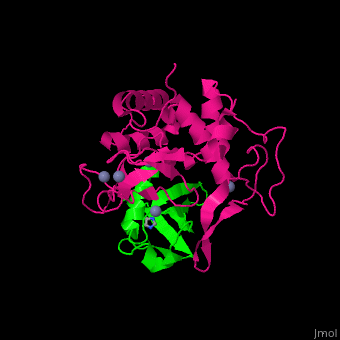Ubiquitin protein ligase
From Proteopedia
(Difference between revisions)
| Line 1: | Line 1: | ||
| - | + | <StructureSection load='4ljo' size='400' side='right' caption='Human UPL HOIP (magenta) complex with ubiquitin (green), imidazole and Zn+2 ion (grey) [[4ljo]]' scene='53/537519/Cv/1' > | |
| - | + | ||
| - | <StructureSection load='4ljo' size=' | + | |
== Function == | == Function == | ||
'''Ubiquitin-protein ligase''' (UPL) ('''E3''') in combination with ubiquitin-conjugating enzyme (E2) causes the attachment of ubiquitin to lysine in a target protein<ref>PMID:16250895</ref>. '''UPL XIAP''' or '''X-linked Inhibitor of Apoptosis Protein''' stops apoptosis induced by viral infection or by overproduction of caspases. UPL XIAP binds caspase-3, -7 and -9<ref>PMID:17549347</ref>. UPL XIAP is inhibited by Smac – a death signaling protein. | '''Ubiquitin-protein ligase''' (UPL) ('''E3''') in combination with ubiquitin-conjugating enzyme (E2) causes the attachment of ubiquitin to lysine in a target protein<ref>PMID:16250895</ref>. '''UPL XIAP''' or '''X-linked Inhibitor of Apoptosis Protein''' stops apoptosis induced by viral infection or by overproduction of caspases. UPL XIAP binds caspase-3, -7 and -9<ref>PMID:17549347</ref>. UPL XIAP is inhibited by Smac – a death signaling protein. | ||
Revision as of 08:22, 4 December 2016
| |||||||||||
3D Structures of ubiquitin protein ligase
Updated on 04-December-2016
References
- ↑ Ardley HC, Robinson PA. E3 ubiquitin ligases. Essays Biochem. 2005;41:15-30. PMID:16250895 doi:http://dx.doi.org/10.1042/EB0410015
- ↑ Sakemi R, Yano H, Ogasawara S, Akiba J, Nakashima O, Fukahori S, Sata M, Kojiro M. X-linked inhibitor of apoptosis (XIAP) and XIAP-associated factor-1 expressions and their relationship to apoptosis in human hepatocellular carcinoma and non-cancerous liver tissues. Oncol Rep. 2007 Jul;18(1):65-70. PMID:17549347
- ↑ Aguilar C, Lenoir C, Lambert N, Begue B, Brousse N, Canioni D, Berrebi D, Roy M, Gerart S, Chapel H, Schwerd T, Siproudhis L, Schappi M, Al-Ahmari A, Mori M, Yamaide A, Galicier L, Neven B, Routes J, Uhlig HH, Koletzko S, Patel S, Kanegane H, Picard C, Fischer A, Bensussan NC, Ruemmele F, Hugot JP, Latour S. Characterization of Crohn disease in X-linked inhibitor of apoptosis-deficient male patients and female symptomatic carriers. J Allergy Clin Immunol. 2014 Nov;134(5):1131-41.e9. doi:, 10.1016/j.jaci.2014.04.031. Epub 2014 Jun 15. PMID:24942515 doi:http://dx.doi.org/10.1016/j.jaci.2014.04.031
- ↑ Ardley HC, Robinson PA. The role of ubiquitin-protein ligases in neurodegenerative disease. Neurodegener Dis. 2004;1(2-3):71-87. PMID:16908979 doi:http://dx.doi.org/10.1159/000080048
- ↑ Stieglitz B, Rana RR, Koliopoulos MG, Morris-Davies AC, Schaeffer V, Christodoulou E, Howell S, Brown NR, Dikic I, Rittinger K. Structural basis for ligase-specific conjugation of linear ubiquitin chains by HOIP. Nature. 2013 Oct 20. doi: 10.1038/nature12638. PMID:24141947 doi:http://dx.doi.org/10.1038/nature12638
Proteopedia Page Contributors and Editors (what is this?)
Michal Harel, Alexander Berchansky, Tihitina Y Aytenfisu, Joel L. Sussman

